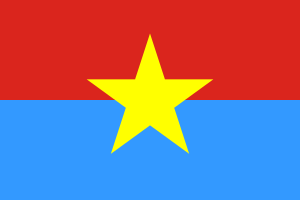Flag of Vietnam facts for kids
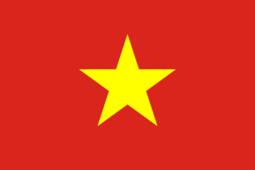 |
|
| Name | Cờ đỏ sao vàng ('Red flag with a golden star') Cờ Tổ quốc ('Flag of Fatherland') |
|---|---|
| Use | Civil and state flag |
| Proportion | 2:3 |
| Adopted | 23 November 1940 (Cochinchina uprising) 2 September 1945 (Democratic Republic of Vietnam) 30 November 1955 (current version) 2 July 1976 (reunified Socialist Republic of Vietnam) |
| Design | A large gold five-pointed star centered on a red field. |
| Designed by | Nguyễn Hữu Tiến (disputed) |
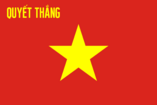
Quân kỳ Quyết thắng
|
|
| Name | Flag of the People's Army of Vietnam |
| Use | War flag |
| Proportion | 2:3 |
| Design | A golden star centered on a red field, and yellow words Quyết thắng (Determining to win) in the upper canton. |
| Designed by | Design is a variant of the flag of Vietnam |
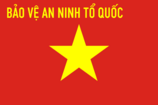
Công an kỳ
|
|
| Name | Flag of the Vietnam People's Public Security |
| Use | Police flag |
| Proportion | 2:3 |
| Design | A golden star centered on a red field, and yellow motto Bảo vệ an ninh Tổ quốc (Protecting the security of the Fatherland) in the upper canton. |
| Designed by | Design is a variant of the flag of Vietnam |
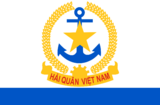
Variant flag of Socialist Republic of Vietnam
|
|
| Name | Ensign of the Vietnam People's Navy |
| Use | Naval ensign |
| Proportion | 2:3 |
| Adopted | 15 January 2014 |
| Design | A white flag with an emblem referring the Vietnam People's Navy in the top with the red label Hải quân Việt Nam ('Navy of Vietnam') and a blue strip below. |
| Designed by | Vietnam People's Navy, with the influence from the naval ensign of the Soviet Navy |
The national flag of Vietnam, officially known as the National flag of the Socialist Republic of Vietnam, is also called the golden-starred red banner (cờ đỏ sao vàng) or the Fatherland flag (cờ Tổ quốc). It was first designed in 1940 during an uprising against French rule. The flag has a bright red background, which stands for the country's struggle and success. In the center is a large golden star. This star represents the spirit of the nation, and its five points symbolize different groups of people in Vietnamese society: thinkers, farmers, workers, business owners, and soldiers.
The flag was first used by the Viet Minh, a group formed in 1941 to help Vietnam become independent from Japanese occupation and French control. After World War II, Vietnam's leader, Ho Chi Minh, declared the country independent. On September 5, 1945, he made the Viet Minh flag the official flag of the Democratic Republic of Vietnam. In 1954, this became the flag of North Vietnam. The flag's design was slightly updated on November 30, 1955, making the star's points straighter. This updated design is still used today. After the end of the conflict in 1975, the red flag of North Vietnam became the flag for the unified country in 1976. Vietnam's flag is unique among ASEAN countries because it does not use the color white. Red and yellow/gold are traditional national colors for Vietnam.
Contents
The National Flag of Vietnam
What the Flag Looks Like and Means
Vietnamese flags have often featured red and bright yellow or gold colors. The 1992 constitution describes the national flag: "The National Flag of the Socialist Republic of Vietnam is rectangular in shape, its width is equal to two thirds of its length, in the middle of fresh red background is a bright five-pointed golden star." This means the flag is red with a golden star in the middle.
The flag first appeared on November 23, 1940, during an uprising in southern Vietnam against French rule. Sơn Tùng, a researcher, wrote in 1981 that the flag was designed by Nguyễn Hữu Tiến. Tiến was a leader of the uprising. He was arrested and executed in 1941. According to a poem Tiến wrote, the red background represents the blood of the people. The yellow color represents "the color of our people’s skin." The five points of the star stand for thinkers, farmers, workers, traders, and soldiers.
For over 2,000 years, yellow (or gold) has been a traditional color in Vietnam. In 2001, Vietnam's Ministry of Culture stated there was no clear proof that Tiến designed the flag. In 2005, Lê Minh Đức suggested another person, Lê Quang Sô, designed it. Đức's theory is based on Sô's son's statements and Sô's memoir. According to Đức, yellow was chosen for Vietnam. The red background was inspired by a political party's flag and represents revolution. Sô tried different star designs. He chose a large star in the center for its good looks. This design was approved by a political party in 1955.
The red background on the Vietnamese flag commonly symbolizes struggle and the success of revolution. The yellow star in the center represents different groups of people in society: business owners, farmers, workers, thinkers, and soldiers. The yellow (or gold) color of the star also represents the Vietnamese people. Sometimes, the flag is flown alongside the flag of the ruling political party in Vietnam.
How the Flag Came to Be
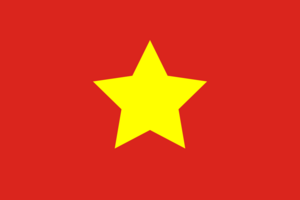
The flag was shown at a meeting on May 19, 1941, when the Viet Minh group was formed. On August 17, 1945, the Viet Minh declared it a "national flag." After World War II, Japan surrendered. The Viet Minh entered Hanoi and declared the "Democratic Republic of Vietnam" on September 2. On September 5, President Ho Chi Minh officially adopted the Viet Minh flag. French troops returned later that month. The National Assembly voted to adopt the flag on March 2, 1946. Ho Chi Minh explained in 1947 that Vietnam chose a star for its flag because of its historical ties with China.
After an agreement between the Viet Minh and France in 1954, the Democratic Republic of Vietnam became the government of North Vietnam. On November 30, 1955, the flag's design was slightly changed. The star became a bit smaller, and its points were made straighter. This change was similar to one made to the flag of the Soviet Union. After the end of the Vietnam War, the flag was adopted in the South. North and South Vietnam united as the Socialist Republic of Vietnam on July 2, 1976. The flag used by North Vietnam from 1945 to 1955 was similar to today's flag, but the star's points were at a wider angle.
Colors and Design Details
Here is an idea of the colors used in the Vietnamese flag. Vietnamese lawmakers have not set exact color standards. So, flags with slightly different shades and proportions are used. Both regular people and state media display them. The main idea is always a "red background with a centered yellow star." The size of the flag can also be adjusted. This happens when the Vietnamese flag is flown with flags from other countries that have fixed sizes, like the Flag of the United States.
| Red | Yellow | |
|---|---|---|
| Pantone | 1788 |
Yellow |
| RGB | 218/37/29 |
255/255/0 |
| Hexadecimal | #DA251D |
#FFFF00 |
| CMYK | 0/83/87/15 |
0/0/100/0 |
Flags from Vietnam's Past
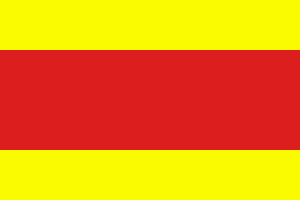
Traditional stories say the Trung sisters wore yellow head coverings during their revolt in AD 40. These were waved to start battles. However, these were more like royal symbols, not national flags. The idea of national flags, representing a whole country, came later during the Nguyễn dynasty. When the French took control of Vietnam in the late 1800s, they flew the flag of France. Different flags were used in various regions under French influence. One notable flag was the Long tinh flag.
Japan occupied Vietnam from 1941 to 1945. In March 1945, Japan removed the French authorities. They declared an Empire of Vietnam with Bảo Đại as emperor. The Quẻ Ly flag, a red symbol on a yellow background, was adopted in June. This symbol often represents the direction south. Bảo Đại stepped down in August when Japan surrendered. The Democratic Republic of Vietnam, declared on September 2, 1945, adopted the red flag with a golden star. The French returned later that month. They faced challenges from the Vietminh, especially in the North. The French created a separate government in southern Vietnam in June 1946. This government used a flag with three blue stripes on a yellow background.
In 1948, Emperor Bảo Đại adopted the flag of South Vietnam. This flag had a yellow background with three horizontal red stripes. The three stripes represented a symbol called Quẻ Càn, which means heaven. On June 2, 1948, Prime Minister Nguyễn Văn Xuân officially adopted this flag. He described it as: "a flag of yellow background, the height of which is equal to two-thirds of its width. In the middle of the flag and along its entire width, there are three horizontal red bands. Each band has a height equal to one-fifteenth of the width. These three red bands are separated from one another by a space of the band's height." This flag was later used by the Republic of Vietnam, also known as South Vietnam.
On June 8, 1969, the National Liberation Front of South Vietnam adopted a flag. It was a three-color flag, similar to North Vietnam's flag. It had a red top half, a blue bottom half, and a yellow star in the center. This flag replaced the yellow flag after the end of the Republic of Vietnam. It was used until Vietnam officially reunited on July 2, 1976.
Images for kids
-
Vietnamese flag flown in Hạ Long Bay
-
Flag of Vietnam in front of the Ho Chi Minh Mausoleum
-
The national flag beside the flag of the Communist Party of Vietnam
-
Flag flown half-staff at the Ho Chi Minh Mausoleum during the state funeral of Gen. Võ Nguyên Giáp
-
An aircraft of VietJet Air with the national flag painted below the windshield. The yellow-star-on-the-red-background symbolism of the Vietnamese flag is also used to decorate the engine.
-
Jersey of the Vietnam national football team featuring the national flag
-
Supporters of the Vietnam national football team wearing attire that is visually inspired by the National Flag in the 2019 AFC Asian Cup
-
Jungle of flags used by Vietnamese citizens during the celebration of Vietnam's victory in the 2018 AFF Championship
-
The funeral of Nguyễn Phú Trọng, displaying the Vietnamese flag with a black ribbon on the top right corner.
-
Vietnam People's Army Honor Guards hosting a ceremony to welcome U.S. SecDef Jim Mattis, featuring the force's war flag which is the Vietnamese flag defaced with the military's motto.
-
The Vietnamese flag being hoisted alongside the American flag in the Government Office during Biden's 2023 state visit to Vietnam.
Flags That Look Alike
-
Flag of the Communist Party of Vietnam, designed with similarities to the national flag of Vietnam.
See also
 In Spanish: Bandera de Vietnam para niños
In Spanish: Bandera de Vietnam para niños
- Flag of South Vietnam
- List of flags of Vietnam



